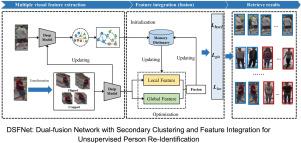DSFNet:基于二次聚类和特征集成的双融合网络,用于无监督人员再识别
IF 15.5
1区 计算机科学
Q1 COMPUTER SCIENCE, ARTIFICIAL INTELLIGENCE
引用次数: 0
摘要
无监督人再识别(ReID)旨在通过更新记忆字典来训练模型,从而从不同的摄像机视图中检索感兴趣的人。由于数据处理成本低,这一领域最近引起了广泛的兴趣。现有的方法主要集中在利用单一的、固定的优化方法(网络)来聚类所有特征,忽略了它们的多样性和完整性,从而导致有噪声的伪标签。为了解决这一问题,本研究提出了一种DSFNet框架,即无监督人ReID任务的二次聚类和特征集成双融合网络(DSFNet)框架。提出的框架由三个主要部分组成:(i)硬样本二级聚类网络(SCNet), (ii)特征集成网络(FINet)和(iii)双融合动态优化(DDO)方案。具体来说,第一个模块侧重于通过硬样本(类内的不同样本或类间的相似样本)二级聚类策略初始化内存字典,该策略保留了个体特征的多样性。FINet通过一个集成的权重分配策略来探索每个人的局部和全局特征,以确保单个实例特征的完整性。其次,从FINet到SCNet实现双融合动态优化方案,从而保证聚类特征的一致性,最终减轻伪标签生成的噪声。大量的实验结果表明,与常用ReID数据集(如Market-1501、MSMT17和PersonX)上最新的纯无监督方法相比,我们的方法在mAP上的性能分别提高了1.7%、1.9%和4.0%。同样,Rank@1的性能也分别提高了0.1%、4.6%和1.0%。同时,为了验证该方法的泛化能力,我们在额外的车辆再识别数据集VeRi-776上进行了测试,结果显示该方法的性能与最新方法基本相当。本文章由计算机程序翻译,如有差异,请以英文原文为准。

DSFNet: Dual-fusion network with secondary clustering and feature integration for unsupervised person re-identification
Unsupervised person re-identification (ReID) aims to train a model by updating a memory dictionary to retrieve a person of interest from different camera views. This area has attracted widespread interest recently due to its low cost of data processing. Existing methods predominantly concentrate on utilizing a single, fixed optimization approach (network) for clustering all features, neglecting their diversity and integrity, thereby resulting in noisy pseudo-labels. To solve this problem, this study proposes a DSFNet framework, namely, a Dual-fusion network with secondary clustering and feature integration (DSFNet) framework for unsupervised person ReID tasks. The proposed framework consists of three main components: (i) a hard-sample secondary clustering network (SCNet), (ii) a feature integration network (FINet), and (iii) a Dual-fusion dynamic optimization (DDO) scheme. Specifically, the first module focuses on initializing the memory dictionary via a hard-sample (dissimilar samples in the intra-class or similar samples in the inter-class) secondary clustering strategy, which preserves the diversity of the individual features. The FINet explores each person’s local and global features via an integrated weight-assigned strategy to ensure the integrity of the individual instance features. Next, the dual-fusion dynamic optimization scheme is implemented from FINet to SCNet, thereby guaranteeing consistent clustering features and ultimately mitigates the noise related to the generation of pseudo-labels. Extensive experimental results demonstrate that, compared to the latest pure unsupervised methods on commonly used ReID datasets (such as Market-1501, MSMT17, and PersonX), our approach achieves performance improvements in mAP of 1.7%, 1.9% and 4.0%, respectively. Similarly, Rank@1 performance has seen improvements of 0.1%, 4.6% and 1.0%, respectively. Meanwhile, to verify the generalization capability of our method, we conducted tests on the additional vehicle re-identification dataset VeRi-776, which exhibited performance largely comparable to the latest methods.
求助全文
通过发布文献求助,成功后即可免费获取论文全文。
去求助
来源期刊

Information Fusion
工程技术-计算机:理论方法
CiteScore
33.20
自引率
4.30%
发文量
161
审稿时长
7.9 months
期刊介绍:
Information Fusion serves as a central platform for showcasing advancements in multi-sensor, multi-source, multi-process information fusion, fostering collaboration among diverse disciplines driving its progress. It is the leading outlet for sharing research and development in this field, focusing on architectures, algorithms, and applications. Papers dealing with fundamental theoretical analyses as well as those demonstrating their application to real-world problems will be welcome.
 求助内容:
求助内容: 应助结果提醒方式:
应助结果提醒方式:


